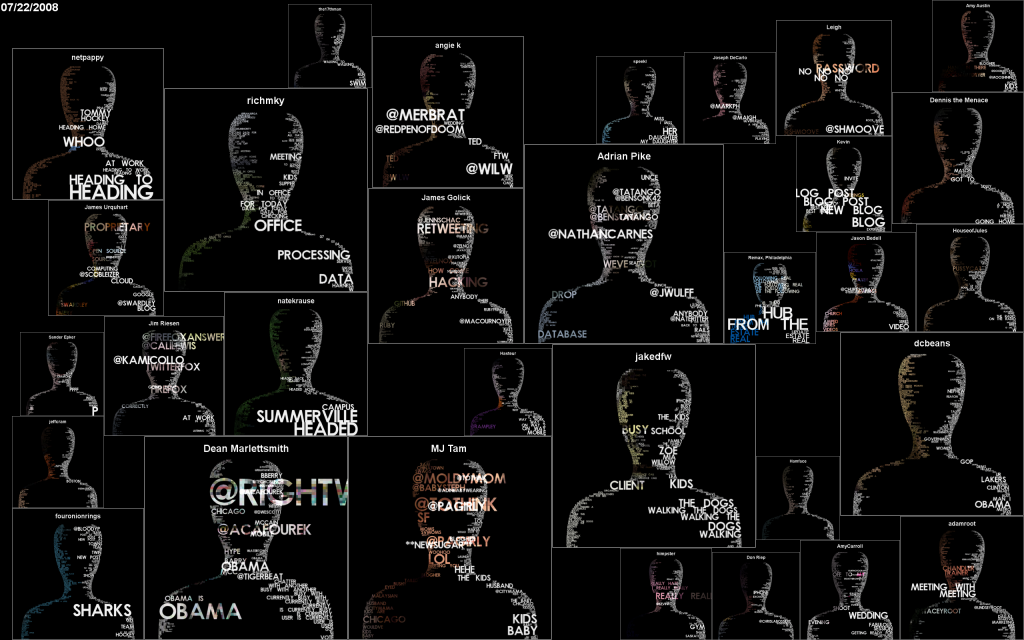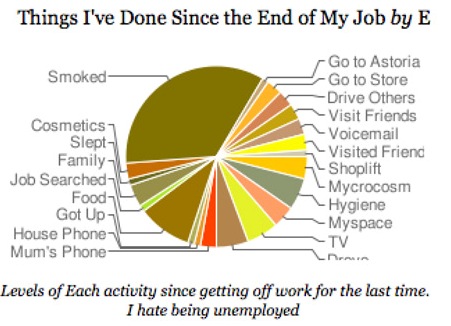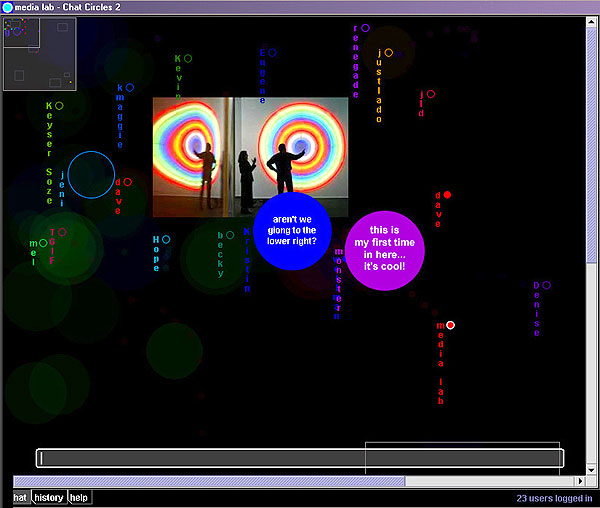I have never met Aaron Zinman. Not in person, anyway. I’ve spoken with him a few times on the phone, and we’ve chatted via email and Twitter, but I’ve never actually seen the man. But for a few months this past summer, Aaron’s art project became an Internet sensation, and I wanted to know why.
A quick web search tells me he’s pursuing a PhD at MIT’s Media Lab, and it looks like he did some interesting things with IBM and Google. Some of his recent Flickr images suggest he likes to go skiing or snowboarding. He’s a DJ, he frequents Cafe Fabulous in Cambridge, and according to his own Twitter feed, he’s “remarkably able at catching falling objects.” In almost all the pictures I’ve seen of Aaron, he’s flashing a big smile, and most of his emails contain at least one smiley, and more than one exclamation mark. Overall, he seems like an intelligent, passionate, likeable kind of guy.

Aaron Zinman, the artist, designer, and technologist behind Personas
I also know through my searching that last year, Aaron launched Personas, which does what I did—search around—and presents its findings. It’s a simple site, designwise, but it reveals a more complex infrastructure and compels us to ask complex questions.
You click over and enter your name. It could be your full name — first, middle, and last. It could be your professional name. Personas then searches the web, like I did for “Aaron Zinman” and uses “a predetermined set of categories that an algorithmic process created from a massive corpus of data. The computational process is visualized with each stage of the analysis, finally resulting in the presentation of a seemingly authoritative personal profile.” In painfully simplistic terms, it Googles you and paints a pretty picture.
Another quick web search shows that Personas quickly took off shortly after it was launched. All kinds of Web sites, from the niche TechCrunch, to the more mainstream CNN talked up the site. It’s easy to see why. Beautifully designed, the clean background shows you what it’s finding and processing in real time, complete with futuristic animations. What comes out is a spectrum of colors and labels, neatly arranged and visually intuitive.

The Personas search results for "An Xiao"
Typing in my name, an uncommon one on both sides of the Pacific, I’m not surprised to find large chunks of the spectrum devoted to “online” and “art.” I assume the slivers of “religion” and “books” relate to my explorations of Zen poetry. I can even see how the “genealogy” result might make sense.
But a few of them puzzle me: Why “military” and “aggression”? Why “sports”? I’ve never campaigned for or against any wars, and the only way I realized the Super Bowl had come and gone was because I was looking at Twitter’s trending topics.
“Personas is an experiment in data portraiture,” Aaron told me. “You get a sense of a machine-kind of thinking and making sense of you. How is the machine parsing you? It’s normally a very opaque process.”
Indeed, watching the animation again, I see other An Xiaos pop up in its searches. There’s “An Xiao Wei,” a kung fu champion. A number of An Xiaos who write academic papers. “An Xiao Qian,” a character in a Chinese action film. Anyone who has the vaguest idea of what I do could tell at a glance that these people obviously aren’t me, but machines can’t recognize that. Not Personas, not Bing, not Google, at least not yet.
Aaron wrote in his project description, that Personas “is meant for the viewer to reflect on our current and future world, where digital histories are as important if not more important than oral histories, and computational methods of condensing our digital traces are opaque and socially ignorant.”
In retrospect, as I learned more about the project, I came to realize that its swift popularity is less a puzzle than an inevitability.
This Internet Life
Personas debuted as part of Connections, an exhibition at the MIT Museum organized by Judith Donath of MIT Media Lab’s Sociable Media Group. It consisted of four sections: Metropath(ologies), which explored a world of constant communication and information flow; Data Portraits, a look at portraiture via digital information; and two spaces for exploring online interaction, Experimental Graphical Chat Spaces and Chit Chat Club.
Formally an art exhibition, Connections was the work of MIT researchers raising questions about the changing landscape of online social interactions. “Particularly with Metropath(ologies),” Judith says, “we didn’t want to say we have an answer. We wanted to make a piece that was very ambivalent about its approach to issues of supervalence and the information around you.”
Walking through Metropath(ologies) was an immersive and at times uncomfortable experience. Tall columns showed projected images of word snippets and images, drawn from personal updates and public sites. I occasionally saw myself among them, captured by surveillance cameras, and I saw words that I could have sworn I was just saying to my companions.
If I could have captured the world of my Web browser, overflowing with tabs and status updates and news reports, it probably wouldn’t have looked much different from Metropath(ologies). The installation, filled with the kinds of wonderful displays and design solutions that one would expect from a show put on by MIT’s Media Lab, helped me see my Web browser later that day in a new light.
“A big part of the Sociable Media Group was visualization,” Aaron explained. “We took spaces and rich histories and visualized them. We pulled from art and artistic endeavors in general.”
The idea of MIT scientists creating thoughtful art projects is counterintuitive. But people like Judith and Aaron are frequently at the forefront of technology and are often best positioned to think through its implications.
Data Portraits, or, The Mechanical Artist Paints by Number
One of the installation artists was Alex Dragulescu, a Romanian-born visual artist who arrived at Media Lab by way of studies in film, animation, and computer animation. In addition to Metropath(ologies), he put together Lexigraphs I, a series of portraits of Twitter users based on their word usage and rhythm.

Sample lexigraphs, courtesy Alex Dragulescu
“My intention was always to sculpt with data,” he told me. “Data has become so pervasive in our lives. Our online communication is the material that makes our digital personas.”
The portraits in Lexigraphs I look like a combination of a word cloud and a passport photo. Unlike a traditional bust, we see very little about the person from the androgynous, featureless form, but we also glean information that a bust could never tell us: the person’s dreams, their anxieties, their daily concerns.
“The word ‘portrait’ was very deliberate,” Judith said. “Like a painted portrait, you have an actual subject. The subject wants to be seen in the best possible light. The audience wants to see them in some meaningful way. The artist may have varying agendas, whether promotion of their own skill or keeping the patron happy.”
“The person,” she added, “is filtered through all these competing interests.”
The idea of making a portrait from data started to sink in as I walked through the Data Portraits section. How often do we think of ourselves nowadays as data results? How often do we Google ourselves to see what comes up, count our Twitter followers, add up the number of ‘likes’ on our latest witty status update? In what sense is our identity developed by algorithms and sums processed and reported by remote servers?
Alex introduced me to the idea of “the mechanical artist.” The mechanical artist, in brief, is a program like Personas and Lexigraphs I that the artist develops but that ultimately produces its own art objects. “Unlike paint or marble, data is much more fluid, and you can work with it through programming or algorithms. The mechanical artist kind of blurs the lines between the art material, the art instrument, the art experience. It can be all these things.”
What Is Portraiture for This Era?
To get a better grasp of the potential of a mechanical artist, I spoke with Fernanda Viegas, a research scientist at IBM, about Themail, a data portrait she developed with Scott Golder. Themail takes email correspondence, finds the frequency of word usage and other context patterns over time and develops a portrait of the subject’s relationship with another person.
“If I could show you visualizations of 15–20 years of your emails,” she asked me, “what would you find out that you didn’t already know? It’s your data, your conversations.” Fernanda tested Themail out with a number of people, and though she took understandable pains to ensure the confidentiality of her subjects, she was surprised to find they wanted to share the portraits immediately.
She continued, “It dawned on me that people were using visualizations as social artifacts, very much the same way we use photographs.”
One of the more striking portraits were those of Yannick Assogba, a Media Lab graduate who now works with Fernanda as a research developer. Yannick developed Mycrocosm, a site that allows users to assemble self portraits using statistical graphs familiar to anyone who has used Excel.

A sample chart from Mycrocosm, courtesy Yannick Assogba
“Microblogging makes it easier to track what we do everyday,” Yannick explained. “How can we make it a more visual experience? There are a lot of infographics now in pop culture, and I wanted to see how we can use it as an expressive tool.”
The charts, which Yannick leaves open for anyone to create and develop, come out surprisingly personal and touching. He told me the story of one person who had lost her job and was tracking the amount of time she was spending looking for work or filling in her time. “It was very emotional,” Yannick said. “Something as dry as a pie chart could be emotional.”
In all of these works lies a simple question that crosses the boundaries of art, technology and the psychology of self. “We live in a world where many of the people you’re in contact with are people you may never see,” Judith said. “What is the portrait for this era?”
Sociable Media
Connections itself is something of a hybrid show. MIT Museum is not normally an art museum. It expressly “showcases the fascinating world of MIT, and inspires people of all ages about the possibilities and opportunities offered by science and technology.” Having more in common with the Air and Space Museum than the National Gallery, most of the museum features quirky interactive displays about robots and design objects.
Likewise, most of the creators behind Connections are primarily scientists and researchers. They functioned as part of Judith Donath’s Sociable Media Group (SMG). Though Judith has recently begun focusing her energies at Harvard’s Berkman Center, the SMG, founded in 1997, looked at applications of online interactions and what we now call social media.

Chat Circles, one of Sociable Media Group's early projects. Image courtesy Fernanda Viegas.
For some perspective, it’s helpful to remember that in 1997, Apple Computer was nearly in the gutter, Microsoft Corporation was quickly becoming the world’s most valuable company, and Larry Page and Sergey Brin were still pursuing their PhDs at Stanford. Most people online were apt to use some combination of electronic mail, Telnet, IRC, and Usenet, and the adventurous few may have been experimenting with AOL Instant Messenger.
I asked Judith why she chose to use the word ‘sociable’ to describe her research group. “‘Social media’ wasn’t a big buzzword then. ‘Sociable’ is a less common word.”
She continued, “I want to somewhat separate the group from the type of research that tends to focus on the utility of social interaction. We really wanted to deal with the socializations among people and less about the hierarchy in this workgroup setting. It’s much more about how people see each other, how they feel about each other.”
One of the SMG’s earlier projects, also on display at Connections, was Chat Circles, a prescient chat program and art project developed in 1999 by Fernanda Viegas and Matt Lee. It was a response to the data overflow of graphical chat spaces like the now-defunct Palace, which did little to capture the flow and energy of conversation in actual physical space. In the latter, we zero in on some conversations and block out others in a process determined as much by attentional energy as by physical distance.
“The thinking back then was that you would create these environments that were big rooms. People would come just to chat,” Fernanda said. “Yes, people definitely want to chat, to meet one another. But context is very important. We need to have our own little homes.”
Context, or, Mother’s Posting on My Wall Again
It’s this study of context that underlies many of the research concerns behind Connections and the Sociable Media Group’s members. “All these cues we rely on in real life—eye gaze, body language—they’re completely missing online,” Aaron said. “There’s nothing there.”
“As we become super overloaded with information, people are offering more information,” he added. “Take retweets. I don’t know anything about the person being retweeted, even after changing the page to see the first ten tweets. Who is this person? What are these links? Technology? Sports? Funny pictures of cats? What are they doing, who are their friends? There are thousands of tiny icons, and no condensed information.”
Indeed, many of my conversations with the Connections artists raised more questions about social media and social interactions online than answers. As technological developments rush forward, at a pace that even I can find overwhelming, it’s comforting to know that at least some of their proponents are encouraging us to take a step back and examine their impact and shortcomings.
“Part of what we really try to get at, particularly when dealing with any kind of social technology, is that the aesthetics and feel of it are an inherent part of the message,” Judith said of SMG. “There’s a tremendous amount of impression formation with anything that’s social. If given an online discussion, if we know about the people, we will build an impression based on just the login name.”
“Once something is social,” she added, “how it looks and feels is really, really important.”
All these things—context, design, social interaction—play a critical role in the effectiveness of any particular form of social media, and it’s starting to take someone with a background in technology, art, and research to piece it all together. The research ideas and their artistic expression in Connections, for instance, help explain why something like Facebook became so popular so quickly.
“One of the things that we did see, which would have been hard to have a vision of ten years ago, is the flourishing of things like Facebook,” Fernanda noted. “Identity is incredibly attractive and important. Like the Facebook Wall—I anchor my conversations with people on my page and your page. That’s meaningful. That’s a context.”
Pop Goes the Art Project
Save for celebrity exhibitions, it is rare for art shows to see much press outside traditional art publications. It is also rare to see anything produced by an academic see the light of day outside journals, except when respun or summarized by a more mainstream reporter.
As both an artistic project and an intellectual exercise by academics, Connections was something of an anomaly for its popularity. Personas, in particular, caught the imaginations of so many; it felt like everyone I knew was tapping their name into the search box to discover what it said about them.
I asked Judith why she thought this happened. “We are in a time where people are in positions where they’re asking what kind of portrait they’re painting online. Now it’s very pervasive. People are realizing they’re leaving all kinds of footprints online. Lots of people recognize something of their own life that’s in Connections.”
Perhaps, then, Connections provided the right mix of ingredients at the right time. Though the Internet has existed for some forty years now, it’s only been in recent years that everyone and their mother—literally—has started using it on a regular basis. It’s inevitable that we’re starting to wonder what it all means and why we’re so drawn to these glowing interfaces. Art that raises and explores all of these questions can engage a broader audience than an academic lecture could.
“With Judith, we wanted to be somewhere in the middle,” Alex explained. “She would give you critiques both from an artistic point of view and a technological point of view. If you are at the intersection of some fields, there might be some innovation in there.”
“There’s a tremendous role for artists,” Judith said. “All these visualizations are certainly interesting as artist’s tools. You’re responding to the society that you’re portraying, the society that you live in.”
Art and Technology: “Much Too Important” for Gimmickry
After speaking with Judith and compiling my notes for this article, I checked into Facebook and Twitter, something I do at least a dozen times each day, if not more so. I watched as update after update flew by, in a near-constant stream of information. I took the subway and checked my email and text messages before I went in, replied to a few while underground, and checked my email and text messages again when I emerged, auto-sending the few I had on queue.
Though I tucked away my phone while with my dinner companion, I kept it on vibrate in case I received an important phone call I was expecting. Then, on my way home, I put on headphones and listened to classical music to calm my nerves while I read the mobile version of The New York Times. Before going to bed, I chatted for a while with my family and checked my messages one more time.
I’ve only been alive for a little more than half of the Internet’s history, but it wasn’t that long ago when none of these technologies existed, or if they did, they were branded as niche, or—even worse—nerdy. But now the ubiquity of mobile and social technology cannot be ignored.
It only seems natural that artists should want to poke at all this. Perhaps the ones who can best see all the angles of possibility and loss, all the contradictions of each new gadget released and embedded into our lives, are the ones who are themselves pushing the technologies forward.
But all artists, I think, regardless of their background and engineering savvy, can tease out these issues. The popular success of Connections suggests that the public interest in this kind of work is growing.
“Hopefully this will be less and less of a challenge in the future, but I don’t think the art world has quite caught up with these changes in technologies,” Judith said. “In some institutions, there’s still a stigma with things having to do with technology. They’re seen as either gimmicky or in the realm of science museums, as opposed to thoughtful.”
“Certainly,” she added, “the issues that are raised by them are much too important to relegate to a world of gimmick.”
Connections
Connections was an exhibition at MIT Museum that ran from February to September 2009. Fortunately, much of the work can be as powerful online as it is in a gallery space. The full list of works can be found at the MIT Museum Web site, and I’ve compiled a list of where you can find them, and the broader work of the individuals in this article, below.
If you are a museum or art space interested in exhibiting Connections, please contact Judith Donath. I’d love to see the exhibition come alive once more.
Personas
Mycrocosm
Themail
Chat Circles
Lexigraphs I




Pingback: Panels, Press and Essays